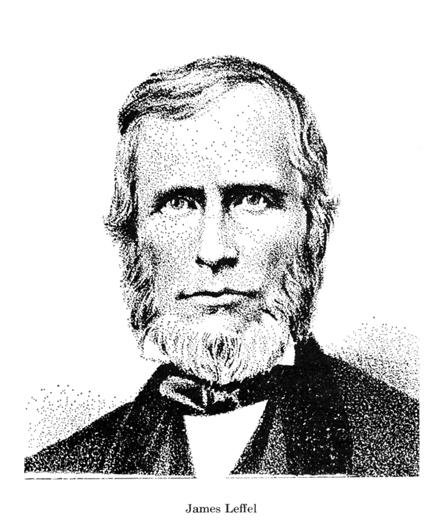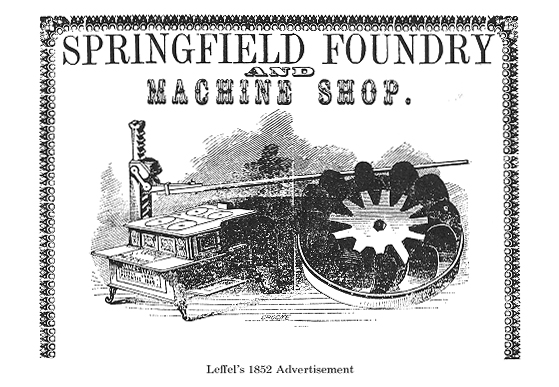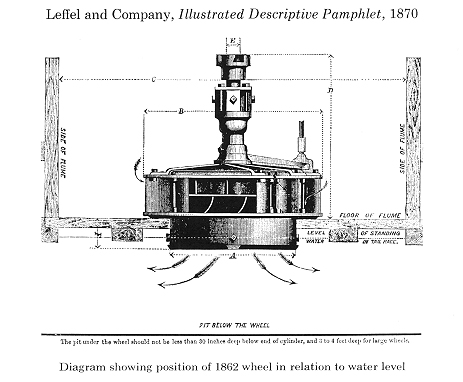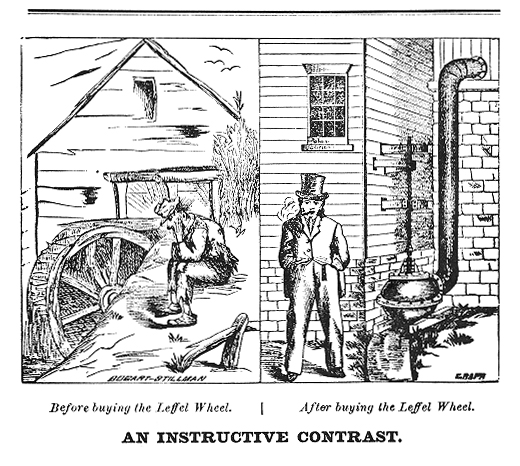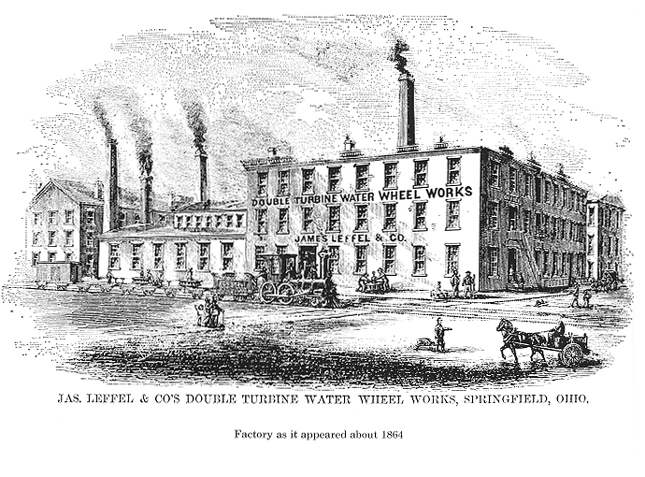Ohio History Journal
|
|
|
JAMES LEFFEL: DOUBLE TURBINE WATER WHEEL INVENTOR
by CARL M. BECKER
Though the evolution of steam engines in the late eighteenth and early nineteenth centuries was a dramatic advance in the development of prime movers, waterpower mechanisms retained substantial importance in the industrial growth of western Europe and the United States. Indeed, European and American inventors were substantially improving conventional water wheels and developing new kinds of fluid mechanisms. Much of
NOTES ARE ON PAGES 269-270 |
JAMES LEFFEL 201
their work simply manifested a
long-continuing process, but in part it
represented a response to the use of
steam power; for in old industrial
regions lacking mineral fuel for the
generation of steam power, the more
efficient use of water offered some
degree of economic salvation.1 Further
stimulating the invention of water power
devices was the spirited debate,
especially in the United States in the
1830's and 1840's, over the relative
merits of water and steam power.
Whatever the causative factors, water
wheels were noticeably improved, and,
more importantly, a new and excit-
ing kind of waterpower mechanism -- the
water turbine -- was progressively
elaborated.
The subject of much experimentation
during the second half of the
eighteenth century but not ready for
practical use then, water turbines
were, when finally effectively designed
by the 1860's, considerably more
sophisticated and efficient in their use
of water than were ordinary wheels.
Older, conventional wheels -- overshot,
undershot, and breast wheels -- all
generated power through the direct
action or pressure of water on buckets or
floats, without the water moving
relative to the wheels. In contrast, in the tur-
bine, which was encased and fixed to a
vertical or horizontal shaft, water
flowed through ducts or vanes,
developing into velocity energy as impulses
and reactions were set up between the
flowing water and the passages. To put
it in a simpler way, water ran over or
under traditional wheels but through
turbine wheels.2 In utilization of power
received, water turbines could
deliver ninety percent effectiveness
while conventional wheels developed
about seventy-five percent
effectiveness. Moreover, turbines cost less to
install, occupied less space and turned
with greater velocity than did
conventional wheels.3
Relatively complicated, the turbine lent
itself to the development of
various types. Two general types in use
by the 1840's were reaction and
impulse wheels. In reaction turbines,
which were completely filled with
water, water entered the runner under
pressure after a portion of its
energy had been converted into velocity
energy. In impulse turbines, which
had to be partially filled with air,
water entered under atmospheric pres-
sure after all its energy had been
converted into velocity energy.4 A basis
for sub-classification was the direction
of the flowing water. The flow could
be radial at right angles to the axis of
revolution, or it could be axial, that
is parallel to the axis of revolution.
Radial flow could be outward or inward;
axial flow could be downward or upward.5
Though the great European
pioneer in the invention of turbines,
Benoit Fourneyron, worked almost
exclusively with outward flow reaction
turbines, the wheels often used in
Europe were the Jonval axial flow
turbine and the Girard impulse turbine.
The Jonval turbine was particularly
effective where large quantities of
water were available under low or medium
heads, not uncommon charac-
teristics of European streams. The
Girard wheel was especially valuable
for use under conditions created by high
falls with small volumes of water.6
In the United States, the dominant type
of turbine was the inward flow
reaction wheel. Wheels of this type
designed by the New England engineer,
202 OHIO HISTORY
James B. Francis, were quite popular.7
Francis wheels and mixed-flow tur-
bines, a modification of inward flow
wheels, were used with good effect where
immense volumes of water were
discharged.8 Initially inefficient in the use
of part-loads, they were gradually
improved by various American inventors
in the second half of the nineteenth
century.
General American interest in water
turbines, following in the wake of
the European movement, which had been
on-going since the 1750's, first
became pronounced in the 1830's and
1840's. During these decades Francis,
Uriah Boyden and George Kilburn, all
engineers active in New England,
were significantly advancing the theory
and practice of water turbine
technology.9 Other inventors of lesser
note were also at work, ever sanguine
as they dispatched their patent
applications to the United States patent
office. Reflecting their efforts, the
number of patents granted for turbines
was increasing in the period.10 Apparently
none were granted in the 1820's;
but about twenty-five were issued in the
1830's and 1840's, twenty in the
1850's, thirty in the 1860's, and, as
momentum gathered, over a hundred
in the 1870's.11 This interest had
mounted despite and because of the rising
challenge of steam power. Waterpower
adherents, by word and inventive
deed, argued their cause; but especially
after 1840 many factories were turn-
ing to steam power as its advocates, led
particularly by Charles T. James,
marshalled convincing evidence of the
economic superiority of steam.12
Despite this fact, by the 1850's, water
turbines still replaced the old style
wheels in many mills; all the pitch-back
wheels at the Appleton Company
in Lowell, Massachusetts, for example,
had been supplanted by turbines.
Among the water turbine men whose
efforts were stamped with the
imprint of ingenuity was James Leffel, a
foundry operator who embodied
many of the classic qualities of the
nineteenth century inventor: steadfastness
of purpose and effort, resilient energy
and optimism, and drive for technical
perfection and productive efficiency.
Born in 1806 in Botetourt County,
Virginia, Leffel was but a baby when his
parents, John and Catherine Leffel,
moved to the Ohio country.13 The
family settled near Donnel's Creek,
several miles west of the hamlet of Springfield,
Ohio. Here the father erected
a sawmill and gristmill.14 Young
Leffel worked, of course, in the mills,
learning general mill technology and
developing particularly an interest
in water wheels. Indeed, as one source
has it, "the construction of rude
models of water wheels, and their
practical application to some boyish
purpose, constituted almost the sole
pastime of the leisure hours of his
youth."15
Leffel first made practical use of his
knowledge of water wheels as a
"mere boy" when sometime in the
1820's he built a sawmill in which he
installed a wheel of his own design and
construction. Supposedly, the mill
was "the most efficient mill in
that section of the country," and the wheel,
demonstrating the "great care . . .
exercised in admitting the water to it,
at once gave proof of an innate
knowledge of Hydraulics possessed by no
other mechanic in the country, even if
of greater age and experience."16
His success soon gave Leffel a beseeching
clientele: "The complete success
JAMES LEFFEL 203
of the undertaking at once drew the
attention of other mill owners; and,
notwithstanding his youth, he was beset
on all sides to re-model wheels
which were now, in comparison,
considered as inefficient." And Leffel was
a heroic mechanic: "With the tact
natural to him, he soon detected the
errors in their construction; and many a
manufacturer was constrained to
praise that youthful skill which, as if
by magic, transformed his hitherto
insufficient power into a valuable and
abundant one."17
For about fifteen years Leffel worked as
a millwright. Acquiring some
skill in metal working and seeing in the
growing population of Springfield
and Clark County (which rose from 13,114
in 1830 to 16,882 in 1840 and
to 22,178 in 1850) a market for sickles,
knives and other small iron imple-
ments, he decided in the late 1830's to
erect his first foundry and machine
shop near the National Road west of
Springfield near Buck Creek. Com-
pleted in early 1840, the foundry was
the first such facility in the Spring-
field area and was the site of much of
his inventive and innovative labors.18
His initial enterprise in iron enjoyed
success from the beginning. Patronage
became so great by 1843 that he decided
to enlarge his productive capacity
and diversify output. His expansion
plans calling for more capital and
skill than he could muster by himself,
Leffel took on two partners, William
A. John, a molder from Columbus, and T.
Y. Ferrell, a finisher from Cin-
cinnati. Acquiring new flasks and cores
and other equipment, the three
proprietors increased the old line of
small implements and also turned
to the production of mill gearing and
stoves. This new work called for a
more sophisticated casting technology
than did the small implement produc-
tion. Stove manufacturing in particular
demanded the careful casting of
strong and irregular shapes, which in
turn entailed problems of even
shrinkage in cooling. Nevertheless,
stove castings soon accounted for much
of the firm's output; the "Queen of
the West," a typical brand name of the
day, became the first important stove in
the firm's line.19
His partnership with John and Ferrell
was the first of a series of busi-
ness associations that Leffel initiated.
In 1845, after apparently terminating
his connections with the foundrymen, he
entered into a partnership with
William Blackeney, a machinist who gave
him invaluable support for
nearly two decades; the two men
continued operation of the foundry,
from which a variety of small iron goods
soon poured forth.20 Then in
1846, Leffel and Andrew Richards,
another energetic Springfield manu-
facturer, joined to build a cotton mill
and machine shop,21 located near
Buck Creek. This latter venture proved
unsuccessful, however, and the
facilities eventually were acquired by
the P. P. Mast Company.
As he was organizing his manufacturing
concerns, Leffel was becoming
one of the acknowledged industrial
leaders of Springfield. It was he who
first proposed to skeptical Springfield
manufacturers in the early 1840's that
a race for the effective utilization of
water power could be brought from
the outlying Buck Creek to a main
thoroughfare in the community.22
Leffel envisioned the establishment of a
complex of mills along the race
that would bring trade to the very
doorsteps of merchants and manufacturers.
204 OHIO HISTORY
He pressed his "favorite
scheme" on Samuel and James Barnett, two well-
established gristmill operators, and
they finally cut a race running a one
and one-half mile course from country to
town. Near its terminus, they
erected a "Water Power and Flouring
Mill." And Leffel himself raised
his cotton mill and machine shop by the
race. Several other mills were
soon located along the conduit, which at
its lowest water stage provided
enough power to operate twenty run of
stone.
Though busily engaged in foundry work,
Leffel was more concerned with
water wheel development. He used his
foundry for a series of experiments
in hydraulics and found time to construct
wheels for a number of mills
in the area. Where "economical use
of water was desired," he used a kind
of overshot wheel, which, according to
an adulatory biographer, "was so satis-
factory that he was almost induced to
believe it the most perfect form of wheel
that could be adopted."23 But
he always found some objection to his over-
shot wheel and resolved "to improve
the Turbine so that it would possess
all the excellent qualities of the
Overshot, without its defects." In fact,
This, then, became the great problem of
his life -- to construct a
Turbine Wheel to at least equal, or if
possible to excel, the Overshot,
in all circumstances and conditions.
Never, perhaps, did a man pursue
a fixed purpose with more devotion,
patience and industry. Day after
day, and year after year, the study of
Hydraulics, and experiments
connected therewith, occupied his
leisure hours . . . .
To convey some idea of the immense labor
he performed in this
department, we would say that he
constructed and experimented with
over one hundred different forms of
water wheels. Among these were
the Outward Discharge or Fourneyron
Wheel, the Jonval or Vertical
Discharge, the Center Vent, & c.
Each Different class underwent in
his hands numerous modifications . . .
.24
Despite his massive labors, Leffel
patented but two wheels. His first
patent, received in 1845, was for a
"new and useful improvement on a
bevel centrifugal water-wheel." The
patent was a characteristic inventor's
document, speaking as it did of the
marvelous utility of the wheel. Leffel's
"useful improvement" was the
multiplicity of wheel apertures, which
numbered "five times" as many
as found in ordinary wheels. Thus the
water of one inch or two hundred inches
could "be applied on the periphery
of this wheel to greater advantage than
upon any other known." Accordingly,
asserted Leffel, it would run in low and
sluggish streams "with less fall
than any other wheel." Moreover, in
times of "freshets" or high water,
"when other wheels refuse to
act," it would do a "good business," since
the high water was permitted to gather
toward the center of the wheel
without diminishing wheel speed.25 Though
not a true water turbine, the
wheel incorporated at least one
characteristic feature of turbines: water
ran through it rather than simply upon
the circumference. But neither
reaction nor impulse principles were
utilized in the wheel.
So certain was Leffel of the
effectiveness and salability of this wheel he
gave over a portion of the foundry
capacity to its production. Expecting
to generate a local demand first and
then area demand, he employed the
JAMES LEFFEL 205
wheel in his cotton mill and machine
shop. But his act of faith moved only
a few Springfield manufacturers to a
similar decision, and his roseate hopes
for sales were not realized. Though
continuing to experiment with water
power mechanisms, he turned all of the
foundry facilities back to the
production of older, more marketable and
more prosaic goods for the farm
and home.26
If Leffel had failed in his initial
effort to invent and market a water
wheel, he remained, nonetheless, an
important manufacturer in the com-
munity. By 1850 he had achieved a kind
of security and maturity in his
industrial ventures. He had given up his
interest in the cotton mill, but he,
Richards, and Blackeney had developed a
machine shop and foundry of
considerable size for the time and place
at the site of his first foundry
west of Springfield. According to the
returns of the census of manufacturing
for 1850, capital invested in the
foundry and machine shop was $18,000,
the second largest investment in Clark
County; only the $27,000 of the
Samuel Barnett flour mill exceeded it.27 The works employed fourteen
"hands," the second largest
work force in the county, and produced
annually stoves and machine castings
valued at $15,000, the stoves account-
ing for $10,000 of the total. The
national average for capital invested in
iron foundries was $11,000, and the
national average for capital invested
per worker was $773 -- far below the
$1,300 behind each Leffel employee.28
With Leffel providing its inventive
drive, the firm achieved substantial
status in the early 1850's. One
prominent item fashioned in the foundry
in the period was an improved lever jack
that Leffel patented in 1850.
It was, unfortunately, linked with a
tragedy for its inventor; during a trip
to California, where he was selling the
jack, his son, Wright Leffel, was
drowned.29 Leffel's cooking
stoves, the "Buckeye" and the "Double Oven"
or "Red Cook Stove" earned a
good reputation for him among Miami Valley
housewives. Patented in 1849, the
"Double Oven," was supposedly the first
stove in Ohio that threw the flame down
over the oven at the base of
the stove; the oven heretofore was
usually placed in the center of the stove.30
Some forty years later, Ohio's pioneer
historian, Henry Howe, recorded
that the latter was the first cook stove
invented in Ohio and quoted
an old citizen who believed that
"no better has succeeded it."31 For some
reason or other, despite the success of
the firm, Richards left it in 1852.
Nathaniel Cook, a machinist, then joined
Leffel and Blackeney in the
partnership.
With the foundry turning out salable
products of good repute, Leffel
increasingly turned to his water power
endeavors in the mid-1850's. He
improved his facilities for hydraulic
experiments, determined as ever to
be a turbine inventor. As a contemporary
observer put it, he was a "person
who would undertake almost anything he
set his mind to do."32 And "to
do" an improved water turbine
remained his compelling purpose in life.
Finally in 1862 his years of labor bore
fruit. Early in that year he was
granted a patent for a reaction type
turbine wheel.33 The turbine was literally
Leffel's "pride and joy." The
inventor carried his model constantly, placing
|
it under a handkerchief in the crown of his plug hat and withdrawing it for display at the slightest encouragement. He was absorbed in it and could talk of nothing else.34 Leffel demonstrated the effectiveness of his creation in several dramatic ways. In Springfield he erected a mill for the processing of linseed oil, not primarily for oil processing but rather as a showcase for the wheel in produc- tive use.35 Confident of the superiority of his double turbine, he agreed to test it against the center-vent, horizontal wheel designed by Dr. Tobias Kindleberger of Springfield, a pioneer homeopath who had operated a "general manufactory" in the community for two decades.36 The contest was conducted on May 2, 1862 at the Methodist Publishing House, where both wheels were installed side by side. Men from all over the state, reported the Springfield News, came to view the exciting battle of the wheels. "With a sort of ingenious brake attached to the shaft," marvelled the News, "the Leffel wheel made 125 revolutions per minute, and exerted a force of 21 pounds."37 The Kindleberger wheel made only 100 revolutions per minute and exerted a force of 16 pounds; moreover, the Leffel wheel did not use as much water. The News also rejoicingly noted that a Leffel wheel, only ten inches in diameter, had been in use in its own office for several months. There it had been running a large Adams book press, a Northrup cylinder press, and two job presses -- often at the same time. Such practical usage stemmed from Leffel's distrust of test runs, which he believed could not duplicate actual conditions of manufacturing. |
|
Why his invention worked so well, Leffel himself, it was said, could not explain.38 His hydraulic notebook, in which he recorded the results of the encounter with the Kindleberger wheel, indicates, however, more than a fortuitous gathering together of parts by Leffel. Though probably he had developed the wheel's efficiency through laborious trial and error methods, the notebook demonstrates that Leffel was well acquainted with the theory and practice of hydraulic physics.39 Certainly he was confident that he had developed an effective mechanism. He asserted in his patent application that it was capable "of yielding from ninety-two to ninety-five per cent. of the power of the water and a greater per cent. than any other wheel heretofore constructed."40 The wheel, evidently designed to utilize small water-loads, was a reaction turbine with mixed flow, its sets of upper and lower vanes developing inward and downward flow. In the words of one authority, This improved Leffel wheel was a double bucket design, namely, with a ring of upper buckets and a ring of lower buckets immediately below them and arranged so that the water would pass through both of these sets of buckets and on out into the draft tube in the most efficient manner, thereby creating the highest results in power and speed for the amount of water and the fall of water that were being utilized.41 This use of double buckets, a technique apparently never employed by any other manufacturers before or since, was elaborated in later years into a more modern type of wheel.42 |
|
208 OHIO HISTORY
Convinced that he could sell the wheel to mill and factory operators, Leffel dispatched his son, Frederick Leffel, on a mission through the Midwest and East to broadcast the good news and hopefully waited to receive orders. Evidently the son also took a model West to display to miners and millers. The fortunes of the turbine were regularly charted in the pages of the Springfield News. As the paper chronicled the event, the first notable sale of the turbine, marketed as the American Double Turbine, was recorded at Rochester, New York. There, a flour mill operator, needing to grind four hundred barrels of flour in twenty-four hours, asked Blackeney to run a trial with the Leffel wheel. In the trial run, the turbine produced not four hundred -- but seven hundred barrels in the specified time.43 According to the News, the double turbine "knock[ed] the spots off" its competitors in Rochester. Rochester millers who observed the trial run must have agreed with the newspaper assessment: within a few days after the run, they placed at least six orders with Leffel.44 As these orders and more were received in late 1862, Leffel and his partners raised the number of employees working on wheel production from ten to twenty and put them to work "night and day." |
JAMES LEFFEL 209
Leffel himself determined to use his
wheel for productive purposes.
In December of 1862 he purchased five or
six acres of land near Lagonda
Creek in Springfield. Here he intended
to build a large flouring mill that
would be capable of turning out one
hundred barrels of flour a day.
Mechanical power for the milling was to
be supplied by Leffel's double
turbine.45 By March of 1863
the plans for a four story building had been
completed, and the construction work was
ready to begin.46 The subsequent
operation of the mill represented
continuing and dramatic evidence of
Leffel's faith in the double turbine.
Meanwhile Leffel was involved in
re-ordering his business interests.
Sometime in 1863 he and Blackeney formed
a new firm, evidently a joint
stock company, taking on as associates
Perry Betchel and Leander Mudge,
two rather non-descript businessmen.
Physical changes were also taking
place. By March of 1863 the demand for
the "best [wheel] in the known
world" had increased so much that Leffel expected to increase
the work
force from twenty to over a hundred and
fifty in the "coming season."47
In December of 1863 he arranged the
purchase for $6,000 of the Springfield
property on the corer of Limestone and
Washington streets owned by
the Pitts Machine Works, the
manufacturers of the thresher invented by
John and Hiram Pitts in 1834.48 Soon a
foundry designed solely for the
production of the "celebrated"
wheel was being erected on the site.49
The building, 107 feet by 50 feet in
exterior dimensions, was completed
in March of 1864. Before production in
the facility could begin, Leffel
had to fabricate the machinery for
manufacturing the wheel.50 Once fitted
with machinery, the foundry employed
more than fifty men. Despite the
mounting success of their business, the
partners evidently did not get on
well together. Betchel left the firm in
early 1864 and was replaced by Henry
Barnett. But, as one observer later put
it, the "combination did not seem
to be progressive and desirable,"
and in 1864 still another reorganization
was effected.51 This time Leffel joined
with John Foos and James S. Goode
in forming a stock company, James Leffel
and Company. Blackeney, Lef-
fel's long-time associate, did not
continue in the business. Foos was a well-
known linseed mill operator, and Goode
was a lawyer and jurist who
had been mayor of Springfield in the
1850's.52 A year later, in 1865, yet
another organizational change occurred.
Now Goode and Foos took their
leave, and Leffel's son-in-law, John W.
Bookwalter, and William Foos
entered the firm with Leffel; the firm's
name then became The James
Leffel and Company.53
All the while demand for the double
turbine increased. Orders for it
totalled forty-seven in 1862, rose
modestly to sixty-two in 1863, and jumped
to 153 in 1864.54 Initially,
orders came largely from the mid-western and
middle eastern states -- from towns and
cities in Ohio, Indiana, Michigan
Pennsylvania and New York -- from
Dayton, Indianapolis, Pittsburgh and
Rochester. Customers were flour mill
operators, woolen goods manufacturers,
paper producers and farm equipment makers,
to name a few. By 1864
the wheel was reaching national and
international markets; orders were
|
being received from points in Massachusetts, Connecticut, Minnesota and Canada. The hardworking Mormons of the Utah Territory looked with favor on the American Double Turbine; one Joseph Croft of Salt Lake City, representing a number of millers there, ordered fourteen wheels of assorted sizes costing over $3,000. In 1865 orders totalling over $37,000 were received from California and Oregon, the western regions to which Leffel's son, Frederick, had carried a model on a sales trip. Prices varied, depending, of course, upon wheel size. Typical sizes ranged from thirty inches to forty inches in width, their prices in 1862 running from $350 to $500, with complementary gear resulting in different prices for identical models. Smaller wheels were ten and thirteen inches and usually were priced below $200. The largest one manufactured in the early years was a fifty-six inch wheel, ordered by Andrew Erkenbrecher of Cincinnati at a cost of $700. The success of the American Double Turbine probably was the result of various factors. Certainly the reputed effectiveness of the wheel com- mended it to potential buyers. Its efficiency with both full- and part-water loads widened its market. The variety of users suggests that it could be adapted to varying water conditions. Though prices of comparable wheels are not known, Leffel's evidently was competitively priced. The range of prices, moreover, fell within the reach of small producers, thus giving the wheel access to a large market. Its workmanship was excellent, an attribute perhaps stemming from Leffel's experience with stove castings. Its low |
JAMES LEFFEL 211
cost of maintenance and durability
further enhanced its position in the
market.55 Little
is known about Leffel's marketing methods, but clearly he
did seek to generate demand beyond the
Springfield area, dispatching as
he did his son on sales trips throughout
the nation and sending the wheel
to the East for trial runs.
Whatever the factors behind the
popularity of his wheel, Leffel was not
destined to enjoy long the fruits of his
success. In 1866 he died, but his
double turbine wheel and his name were
firmly rooted in the industrial scene
of Springfield. By 1870 the company
bearing his name could boast a capital
investment of $120,000, and its annual value
of production had reached
$371,400; turbine production alone
accounted for $250,000.56 The firm
employed sixty-five men, who were
primarily working on the turbines. With
his water turbine the small foundryman
had laid the foundations of a great
company; The James Leffel & Company
still exists in Springfield and con-
tinues to manufacture hydraulic turbines
as well as scotch boilers and
stokers. It stands today as a monument
to a man of genius and tenacity;
well might his motto have been Tenax
propositi.
THE AUTHOR; Carl M. Becker is In-
structor of History, Wright State
Univer-
sity.
